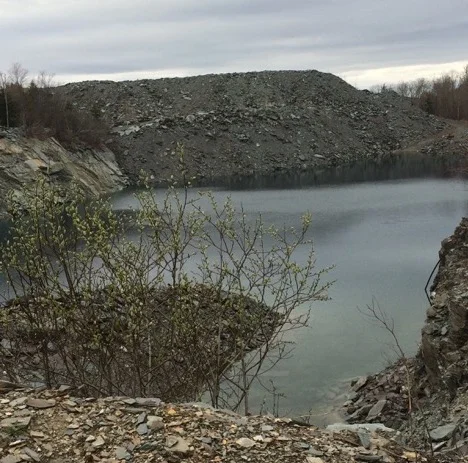Article by Beth Roberts Brown and Susan Davies Sit Nothing is guaranteed when you drive up to upstate NY and VT in April, especially the weather. Even though spring was slow coming to CT, we must have thought that VT was warm enough for light jackets, as it had been in CT that week. As we drove though snow showers and the temperature dropped to 34F, we knew we were woefully dressed for the day.
However, the day was indeed wonderful! After a bagged lunch on the road, watching the snow, we arrived at the Slate Museum in Granville, NY in time for a tour of the museum with Bob Isherwood who had prepared a program for us which included the showing of a video depicting a working quarry. One of the voices telling of a narrow escape from death was my uncle, Charlie Roberts, very much alive today at 96. It was spine chilling to hear his voice.
In 1839, as Caleb Raney, a farmer, was about to sell the property, he discovered slate on his land. By the late 1800’s slate quarries quickly spread throughout the valley. Bob took us on a car tour of several points of interest including quarry housing, a derelict quarry pit filled with water, the last remaining quarry stick in the area, Elmwood Cemetery with many stones engraved in Welsh, with Welsh flags next to them. Each stone we passed had a story to tell. We also visited the areas of Blissville and Jamesville where some of the earliest slate was quarried and my family first settled before moving to the larger town of Granville, as well as the ruins of a large mill, in which a fire in 1871 made the New York Times, such was the importance of this operation. A small building with a purple slate roof dating back to 1851 still stands and was a schoolroom and a chapel.
Welsh immigration from slate quarries in Snowdonia, Northern Wales such as Ffestiniog, Dinorwic and Bethesda began around 1850 and the 1850 US Census shows that 18 people of Welsh birth lived in Granville, NY alone – 13 males and 5 females. Many of the surrounding towns (Fair Haven, West Castleton, Poultney and Middle Granville) were also home to Welsh born families. In 1852, thirty Welsh settlers arrived in Middle Granville (SlateValleyMuseun.org) and three hundred more in 1891. In the 1900 census for the Granville area, there are 677 Welsh born persons. Occupations are almost all involved in the slate industry, such as Slate Boss, Slate Worker, Trimmer, Miner, Block Cutter, Splitter.
What made this excursion extra special to me was that this was my hometown. I grew up here in the 40’s, my Dad grew up here, his parents, grandparents and great grandparents. This became home to the family after leaving Wales around 1860. We are a blend of Roberts, Jones, Williams and Rowlands. David W. Roberts and Catherine Jones CwmDyli named after an aunt instead of the family name of Roberts came from the Beddgelert area, John Rowlands and Ann Williams Boarding from Llanllyfni or Penygroes, and Ebenezer and Margaret Jones from the Bethesda/Bangor area. As we searched the area and saw piles of slate looming near the road and through the trees memories came flooding back of watching my Taid and Uncles leaving in the early morning dressed for work including shiny lunch buckets and returning late afternoon covered in slate dust and toting lunch buckets that no longer had a shine. Every quarry had several quarry sticks and today there is only one left. My earliest memories are about living in “the long houses”, which I later discovered were “workers’ housing”. Our visit made me realize how much history the town that I hadn’t been able to wait to leave, had to share now and how much I really wanted to learn more about the area, my family, their struggles and to share their stories with my children and grandchildren.
Genealogy research can help unlock some of the family mystery. Our group, directed by our President, Susan Davies Sit does just that.
Article by Beth Roberts Brown and Susan Davies Sit.



